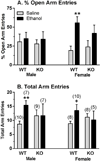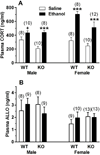Sex Differences in Ethanol's Anxiolytic Effect and Chronic Ethanol Withdrawal Severity in Mice with a Null Mutation of the 5α-Reductase Type 1 Gene
- PMID: 25355320
- PMCID: PMC4417087
- DOI: 10.1007/s10519-014-9691-5
Sex Differences in Ethanol's Anxiolytic Effect and Chronic Ethanol Withdrawal Severity in Mice with a Null Mutation of the 5α-Reductase Type 1 Gene
Abstract
Manipulation of endogenous levels of the GABAergic neurosteroid allopregnanolone alters sensitivity to some effects of ethanol. Chronic ethanol withdrawal decreases activity and expression of 5α-reductase-1, an important enzyme in allopregnanolone biosynthesis encoded by the 5α-reductase-1 gene (Srd5a1). The present studies examined the impact of Srd5a1 deletion in male and female mice on several acute effects of ethanol and on chronic ethanol withdrawal severity. Genotype and sex did not differentially alter ethanol-induced hypothermia, ataxia, hypnosis, or metabolism, but ethanol withdrawal was significantly lower in female versus male mice. On the elevated plus maze, deletion of the Srd5a1 gene significantly decreased ethanol's effect on total entries versus wildtype (WT) mice and significantly decreased ethanol's anxiolytic effect in female knockout (KO) versus WT mice. The limited sex differences in the ability of Srd5a1 genotype to modulate select ethanol effects may reflect an interaction between developmental compensations to deletion of the Srd5a1 gene with sex hormones and levels of endogenous neurosteroids.
Conflict of interest statement
Ms. Michelle Tanchuck-Nipper, Dr. Matthew Ford, Ms. Anna Hertzberg, Dr. Amy Beadles-Bohling, Dr. Debra Cozzoli, and Dr. Deborah Finn declare that they have no conflict of interest.
All institutional and national guidelines for the care and use of laboratory animals were followed.
Figures






References
-
- Alele PE, Devaud LL. Sex differences in steroid modulation of ethanol withdrawal in male and female rats. J Pharmacol Exp Ther. 2007;320:427–436. - PubMed
-
- Barbaccia ML, Affricano D, Trabucchi M, Purdy RH, Colombo G, Agabio R, Gessa GL. Ethanol markedly increases ‘GABAergic’ neurosteroids in alcohol-preferring rats. Eur J Pharmacol. 1999;384:R1–R2. - PubMed
-
- Belelli D, Lambert JJ. Neurosteroids: Endogenous regulators of the GABAA receptor. Nature Rev Neurosci. 2005;6:565–575. - PubMed
-
- Bergeson SE, Warren RK, Crabbe JC, Metten P, Erwin VG, Belknap JK. Chromosomal loci influencing chronic ethanol withdrawal severity. Mamm Genome. 2003;14:454–463. - PubMed
Publication types
MeSH terms
Substances
Grants and funding
LinkOut - more resources
Full Text Sources
Other Literature Sources
Molecular Biology Databases
Research Materials

